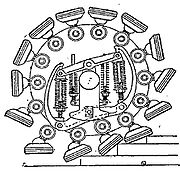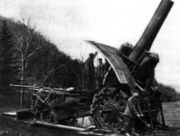
Pedrail wheel
Encyclopedia

Agricultural machinery
Agricultural machinery is machinery used in the operation of an agricultural area or farm.-Hand tools:The first person to turn from the hunting and gathering lifestyle to farming probably did so by using his bare hands, and perhaps some sticks or stones. Tools such as knives, scythes, and wooden...
and was considered as a possible technique for the development of the tank
Tank
A tank is a tracked, armoured fighting vehicle designed for front-line combat which combines operational mobility, tactical offensive, and defensive capabilities...
in World War I
World War I
World War I , which was predominantly called the World War or the Great War from its occurrence until 1939, and the First World War or World War I thereafter, was a major war centred in Europe that began on 28 July 1914 and lasted until 11 November 1918...
, but was ultimately replaced by the more robust continuous track mechanism.
Definition
According to the 1913 Webster's Revised Unabridged Dictionary, a pedrail is:Invention
The pedrail wheel was invented in 1903 by the Londoner Bramah Joseph DiplockBramah Joseph Diplock
Bramah Joseph Diplock was an English inventor who invented the pedrail wheel in 1903.He also invented the pedrail locomotive which was featured in the 7 February 1904 New York Times....
. It consists in the adjunction of feet (Latin radical "ped") to the rail of a wheel, in order to improve traction and facilitate movement in uneven or muddy terrain. Sophisticated pedrail wheels were designed, with individual suspension for each foot, which would facilitate the contact with uneven terrain.
Bramah Joseph Diplock also invented the pedrail locomotive
Locomotive
A locomotive is a railway vehicle that provides the motive power for a train. The word originates from the Latin loco – "from a place", ablative of locus, "place" + Medieval Latin motivus, "causing motion", and is a shortened form of the term locomotive engine, first used in the early 19th...
which was featured in the 7 February 1904 New York Times.
Fiction

H. G. Wells
Herbert George Wells was an English author, now best known for his work in the science fiction genre. He was also a prolific writer in many other genres, including contemporary novels, history, politics and social commentary, even writing text books and rules for war games...
, in his short story The Land Ironclads
The Land Ironclads
Written by H. G. Wells, "The Land Ironclads" is a short story that originally appeared in the December 1903 issue of the Strand Magazine and set in a war similar to the First World War...
, published in The Strand Magazine in December 1903, described the use of large, armoured cross-country vehicles, armed with cannon and machine guns, and equipped with pedrail wheels, to break through a system of fortified trenches, disrupting the defence and clearing the way for an infantry advance:
In War and the Future, H.G. Wells acknowledged Mr. Diplock's pedrail as the origin for his idea of an all-terrain armoured vehicle:
World War I

World War I
World War I , which was predominantly called the World War or the Great War from its occurrence until 1939, and the First World War or World War I thereafter, was a major war centred in Europe that began on 28 July 1914 and lasted until 11 November 1918...
, as trench warfare
Trench warfare
Trench warfare is a form of occupied fighting lines, consisting largely of trenches, in which troops are largely immune to the enemy's small arms fire and are substantially sheltered from artillery...
immobilized the front, proposals were made for pedrail machines that could make their way to enemy lines: in June 1914, Major Glasfurd
Duncan John Glasfurd
Brigadier General Duncan John Glasfurd was a British Army and later Australian Army colonel and temporary Brigadier General in World War I. He was mentioned in dispatches for his role in evacuating Anzac...
, who was fighting in France, proposed an idea for such a pedrail machine.
The Royal Navy
Royal Navy
The Royal Navy is the naval warfare service branch of the British Armed Forces. Founded in the 16th century, it is the oldest service branch and is known as the Senior Service...
and the Landships Committee
Landships Committee
The Landships Committee was a small British war cabinet committee established in February 1915 to deal with the design and construction of what would turn out to be tanks during the First World War...
(established in February 1915), largely at Winston Churchill
Winston Churchill
Sir Winston Leonard Spencer-Churchill, was a predominantly Conservative British politician and statesman known for his leadership of the United Kingdom during the Second World War. He is widely regarded as one of the greatest wartime leaders of the century and served as Prime Minister twice...
's urging, agreed to sponsor experiments and tests of armoured tractors as a type of "land ship". In March 1915, Churchill ordered the building of 18 experimental landship
Landship
A landship is a large vehicle that travels on land, as opposed to on water, air, or in space. Because of their large size, their use on land is seen as impractical due to terrain obstacles, and soft ground that cannot support such large weight. Such problems are non-existent on water and in space...
s: 12 using Diplock
Bramah Joseph Diplock
Bramah Joseph Diplock was an English inventor who invented the pedrail wheel in 1903.He also invented the pedrail locomotive which was featured in the 7 February 1904 New York Times....
pedrails, and 6 using large wheels, but construction failed to move forward, as the wheels seemed impractical, and the pedrails met with industrial problems. When these attempts had failed by July 1915, continuous tracks were tested, and they soon became the technique of choice for the development of the tank
Tank
A tank is a tracked, armoured fighting vehicle designed for front-line combat which combines operational mobility, tactical offensive, and defensive capabilities...
. The pedrail was considered as too weak for an all-terrain armoured machine, and "caterpillar" continuous tracks were ultimately preferred.
The system was also used as a way to prevent weapons from bogging down in muddy roads, by spreading the load, as in heavy guns such as the Big Bertha
Big Bertha (Howitzer)
Big Bertha Bertha") is the name of a type of super-heavy howitzer developed by the famous armaments manufacturer Krupp in Germany on the eve of World War I...
. It was also incorporated in early Four-wheel drive
Four-wheel drive
Four-wheel drive, 4WD, or 4×4 is a four-wheeled vehicle with a drivetrain that allows all four wheels to receive torque from the engine simultaneously...
designs.

